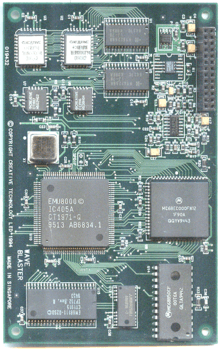Creative Wave Blaster

The Wave Blaster was an add-on MIDI-synthesizer for Creative Sound Blaster 16, Sound Blaster AWE32, and AWE64 family of PC soundcards. It was a sample-based synthesis General MIDI compliant synthesizer. For General MIDI scores, the Wave Blaster's wavetable-engine produced more realistic instrumental music than the SB16's onboard Yamaha-OPL3.
The Wave Blaster attached to a SB16 through a 26-pin expansion-header, eliminating the need for extra cabling between the SB16 and the Wave Blaster. The SB16 emulated an MPU-401 UART, giving existing MIDI-software the option to send MIDI-sequences directly to the attached Wave Blaster, instead of driving an external MIDI-device. The Wave Blaster's analog stereo-output fed into a dedicated line-in on the SB16, where the onboard-mixer allowed equalization, mixing, and volume adjustment.
The Wave Blaster port was adopted by other sound card manufacturers who produced both daughterboards and soundcards with the expansion-header: Diamond, Ensoniq, Guillemot, Oberheim, Orchid, Roland, TerraTec,[1] Turtle Beach,[2] and Yamaha. The header also appeared on devices such as the Korg NX5R MIDI sound module, the Oberheim MC-1000/MC-2000 keyboards, and the TerraTec Axon AX-100 Guitar-to-MIDI converter.
Since 2000, Wave Blaster-capable sound cards for computers are becoming rare. In 2005, Terratec released a new Wave Blaster daughterboard called the Wave XTable with 16mb of on-board sample memory comprising 500 instruments and 10 drum kits. In 2014, a new compatible card called Dreamblaster S1 was produced by the Belgian company Serdaco. In 2015 that same company released a high end card named Dreamblaster X1, comparable to Yamaha and Roland cards.
WaveBlaster II

Creative released the Waveblaster II (CT1910) shortly after the original Waveblaster. Waveblaster II used a newer E-mu EMU8000 synthesis-engine (which later appeared in the AWE32). Some people believe that, despite using a smaller 2MB instrument ROM (vs 4MB of the original Waveblaster), the Waveblaster II delivered better renditions in most MIDI-scored games, likely due to what they feel is better sample refinement and balancing between instruments.
While the original Waveblaster greatly improved upon the acoustic quality of the SB16's built-in FM-synthesis, the acoustic quality of its instrument-set was poorly regarded. By the time the SB16 reached the height of its popularity, competing MIDI-daughterboards had already pushed aside the Waveblaster. In particular, Roland's Sound Canvas daughterboards (SCD-10/15), priced higher than Creative's offering, were highly regarded for their unrivalled musical reproduction in MIDI-scored game titles. (This was due to Roland's dominance in the production aspect of the MIDI game soundtracks; Roland's daughterboards shared the same synthesis-engine and instrument sound-set as the popular Sound Canvas 55, a commercial MIDI module favored by game composers.) By comparison, the WaveBlaster's instruments were improperly balanced, with many instruments striking at different volume-levels (relative to the de facto standard, Sound Canvas.)
Reception
Computer Gaming World in 1993 praised the Wave Blaster's audio quality and stated that the card was the best wave-table synthesis device for those with a compatible sound card.[3]
WaveBlaster Connector Pinout
| Pin | Function | Pin | Function |
|---|---|---|---|
| 1 | DGnd | 2 | - |
| 3 | DGnd | 4 | TTL-MIDI input |
| 5 | DGnd | 6 | +5 Volts |
| 7 | DGnd | 8 | TTL-MIDI output |
| 9 | DGnd | 10 | +5 Volts |
| 11 | DGnd | 12 | Audio R in |
| 13 | - | 14 | +5 Volts |
| 15 | AGnd | 16 | Audio L in |
| 17 | AGnd | 18 | +12 Volts |
| 19 | AGnd | 20 | Audio R out |
| 21 | AGnd | 22 | -12 Volts |
| 23 | AGnd | 24 | Audio L out |
| 25 | AGnd | 26 | !Reset |
- AGnd = Analog ground
- DGnd = Digital ground
- Some Wave Blaster cards offer audio inputs ( Yamaha DB50XG )
- Some Wave Blaster cards offer TTL-MIDI output
- Reset is active low
References
- ↑ Walker, Martin. "Terratec Audiosystem EWS64 XXL". Sound On Sound (July 1999).
Note: they also sold Microwave PC (multiple-wavetable synthesizer module). - ↑ "Turtle Beach HOMAC (Rockwell / Kurzweil) Wavetable Daughterboard, 4MB". AmoRetro.de.
Note: using Kurzweil sound on Rockwell chip. - ↑ Weksler, Mike; McGee, Joe (October 1993). "CGW Sound Card Survey". Computer Gaming World. pp. 76–83. Retrieved 26 March 2016.
External links
- Waveblaster pin-out information
- Waveblaster card photos (text in Japanese)
- Waveblaster Card Collection
- 2014 Dreamblaster Module
- 2015 dreamblaster X1 review
- dreamblaster X1 vs Yamaha vs Roland